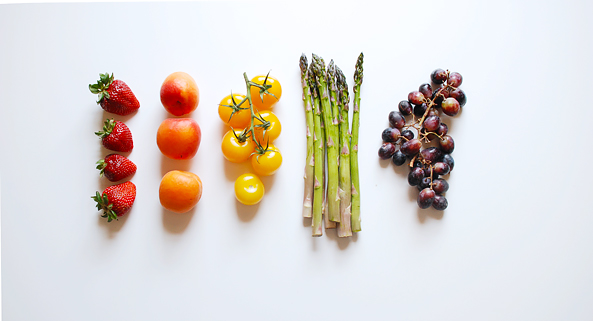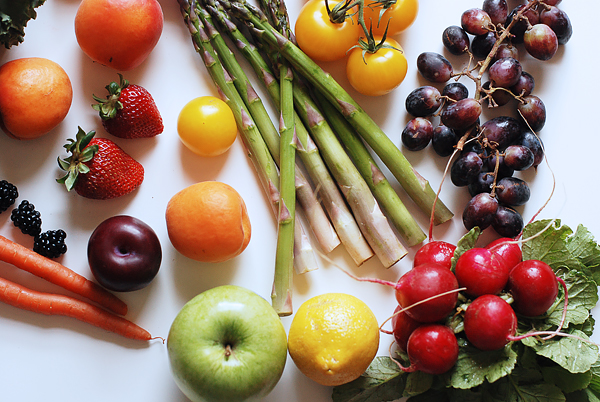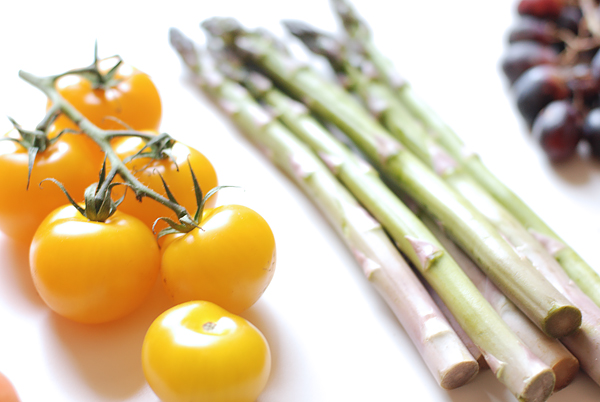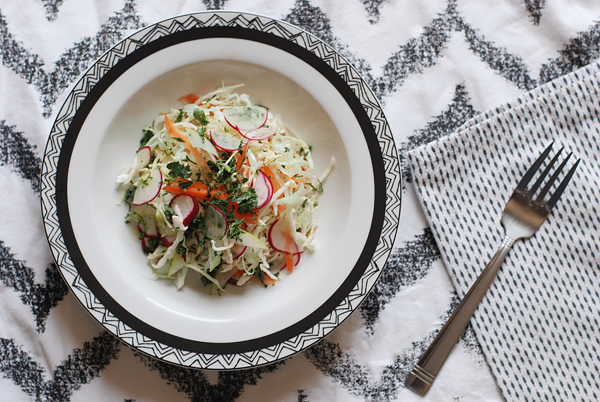GOOD LIVING IS GLAM FOR THE ECO DIVA BEAUTY BLOG – If you spend time in the morning trying to color coordinate your outfit for the day, you should consider doing the same with your food. Packing your plate with a spectrum of vibrant hues is key to a robust diet, and understanding the health benefits associated with each shade is the best way to get started on this colorful journey.
Think about it for a moment: the foods that are the least nutritious lack vivid coloring, such as flour, simple sugars and processed or refined carbohydrates. Of course there are healthy white foods, like cauliflower, onions and white beans, however as a general rule we can equate color with wellness and a lack of color with inflammation and damage to cells, which over time can result in serious health risks and disease.
So how do you give your dishes the rainbow treatment? In order to get the recommended 9 servings of fruits and vegetables per day, I consume the following veggies (which is actually more than 9 servings): 3 cups colorful variety (from the red, yellow, orange groups), 3 cups raw or cooked greens and 3 cups from the sulfur-rich cruciferous family, such as kale, broccoli and cabbage. Let this be your starter guide:
Color: Red
Produce Picks: apples, bell peppers, cherries, cranberries, guava, pomegranates, radish, strawberries, tomatoes, watermelon
Benefits: Lycopene, a powerful antioxidant, is the predominant pigment found in red-hued fruits and vegetables. The lycopene found in tomatoes, for example, has been associated with a reduced risk of some cancers and protection against heart attacks. Loaded with vitamin C and folate, red foods also contain flavonoids, which have antioxidant properties and reduce inflammation.
Color: Orange
Produce Picks: apricots, cantaloupe, carrots, mangoes, persimmons, pumpkin, sweet potatoes, turmeric root, winter squash, yams
Benefits: These foods are commonly referred to as the eyesight foods due to their high vitamin A content, which is known as the vision vitamin. Beta-carotene and alpha-carotene are also present in this family, which can be converted into vitamin A. High in vitamin C and other phytochemicals, these foods can help maintain skin and bone health, assist with blood sugar regulation, and have anti-inflammatory properties that can attack disease-promoting free radicals.
Color: Yellow
Produce Picks: acorn squash, apples, Asian pears, bananas, bell peppers, butternut squash, ginger root, lemons, pineapples, potatoes, squash blossoms
Benefits: Sunny colored foods are teeming with vitamin C, carotenoids and flavonoids. These nutrient rich antioxidants promote eye and skin health, improve brain functions, and contribute to stronger bones and teeth.
Color: Green
Produce Picks: arugula, asparagus, broccoli, brussels sprouts, cabbage, dandelion greens, kale, lettuce, mustard greens, spinach
Benefits: In general, green vegetables are an excellent source of potassium, carotenoids, folic acid and vitamin K. Cruciferous veggies such as cabbage and broccoli contain phytochemicals, which may have anti-cancer properties. So going green means improved eye health, healthier teeth, bones and muscles, and lowered cancer risk.
Color: Blue/Purple
Produce Picks: blackberries, blueberries, eggplant, grapes, purple cabbage, plums, purple cauliflower, purple potatoes,
Benefits: Going deep and dark is a good choice for cancer prevention, protection from heart disease, and for its anti-aging properties. These foods are full of antioxidants associated with maintaining a healthy heart and optimal brain function.
Integrating all of these fruits and vegetables into your diet might seem like a monumental task, but it really isn’t. You can start by just trying to include all of the colors each day, which can be done easily if you mix several colors together in a salad, slaw or juice. If you let the colors guide you, you can create wonderful, bright dishes that help sustain your body every day.




